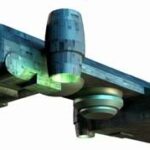This was the biggest war fought in the 34 Tauri solar-system.
–
Table of Contents:
- Alleged Final Cause
- Year by Year
- Result and Main Reasons
- Aftermath Begins
- Location (Images Begin)
- Population Change
- Independent Forces
- Alliance Vessels
- Battles in Order
–
Alleged Final Cause:
The Unification War started with Lao Anbiao’s nomination as Chairperson in the elections of 2505, which triggered a declaration of secession from the Alliance from many colony worlds. Leaders of the “Independent Faction” had long been waiting for an event that might unite the colonies against unification forces, and Anbiao’s hard-lined adherence to an Alliance of all colonized worlds was, most believed, the catalyst necessary.
Once the election returns were certain, a special Independent convention declared “that the union now subsisting under the name of the “Interstellar Anglo-Sino Alliance of Colonized Worlds” is hereby dissolved.” By February 1, 2506, six more systems had seceded.
–
Year by Year:
Keep in mind that the following are just the major battles; dozens of lesser battles, hundreds of skirmishes, and thousands of shootouts, plus untold numbers of hacking events and other clandestine work, all were part of this years-long interplanetary war.
Every world was involved and affected somehow.
Everyone knew someone who died.
- On February 7, the seven systems adopted a provisional constitution for the Independent Colonies. The remaining colonial systems as yet remained in the Alliance.
- February 9, 2506 – The coalition of Independent Colonies is formed (seven border systems are announced as members).
- April 12, 2506 – Independents open fire upon Federal troops stationed on the IAV Sumter on patrol on the Athens moons. The Unification War begins.
- April 17, 2506 – Verbena secedes from the Alliance, followed within 5 weeks by three additional systems who are, as a whole, much closer to the Core worlds than the original Independent colonies, bringing the total number of ‘officially independent’ systems to eleven. In an attempt to prevent more colonial systems from joining the Independents, the Alliance directorate passes the Crighton-Jihau Resolution, which stated that further successions would lead to stiff economic sanctions and tariffs.
- April 19, 2506 – The Alliance directorate issues a blockade against Independent ports. For the duration of the war the blockade limits the ability of the rural Colonies to stay well-supplied in its war against the industrialized Core worlds.
- July 21, 2506 – An Independent force has assembled on Verbena. Alliance troops move against Verbena under General Irvin. Independent General Prudence Vaughn resists the Alliance attacks with a much smaller force and Alliance troops fall back to Osiris.
- July 27, 2506 – The Alliance directorate appoints Geoffrey Devchenko as Commander of the Sihnon Peacekeeping Force and follow this in November with appointment as general-in-chief of all Alliance forces. Devchenko responds, “I can do it all.”
- February, 2507 – Victory for Alliance General Yu Kwan, recapturing Boros.
- April, 2507 – An Independent surprise attack by underground resistance fighters on General Yu Kwan’s unprepared troops on Boros results in 13,000 Alliance troops killed and wounded. Chairperson Anbiao is pressured to relieve Kwan but resists.
- May, 2507 – Independent forces are driven from New Melbourne, holding that key strategic system for the Alliance.
- June, 2507 – Devchenko reached Hera, only to be defeated by General Rui Li (heavy losses on both sides). Devchenko begins a retreat to Osiris and is relieved of duty upon his arrival.
- August, 2507 – Under Devchenko’s successor, General Hildebrand, 75,000 Federals are defeated by 55,000 Independents under General Prudence Vaughn and General Harold Biao at the second Battle of Verbena. Once again the Alliance Army retreats to Osiris.
- September, 2507 – Li invades the Core worlds through the Poseidon Nebula with 550,000 troops, en route to Osiris. Alliance forces under the command of Devchenko pursues Li. Chairperson Anbiao restores Devchenko, who wins a bloody, pyrrhic victory at the Battle of Tietam near Sihnon on September 17. Li’s army returns to Verbena. Devchenko fails to “follow up on the Tietam victory” and is replaced by General Evan Ambrose.
- December, 2507 – General Ambrose suffers a costly defeat on Verbena, with a loss of 12,000-plus troops after 14 frontal assaults. Independent losses are around 5,000.
- January 25, 2508 – The Alliance directorate appoints General Etienne Mordeau as Commander of the Core Alliance force, replacing Ambrose. General Kwan is placed in command of the Border Alliance forces.
- March 3, 2508 – The Alliance Directorate enacts a wartime draft, but exempts those who pay a fee or provide a suitable substitute draftee.
- April, 2508 – Alliance ships take New Dunsmuir on the planet Beaumonde, the Independents’ most accessible ‘Coreward’ spaceport.
- May, 2508 – Alliance forces under General Mordeau are decisively defeated by Prudence Vaughn’s much smaller forces at the Battle of Three Hills as a result of Vaughn’s brilliant tactics, although General Vaughn is mortally wounded by friendly fire. Mordeau retreats. Alliance losses are 17,000 killed, wounded and missing out of 130,000. The Independents, 13,000 out of 60,000.
- May 20, 2508 – The Independents suffer a huge blow as Prudence Vaughn dies from her wounds. “I have lost my right arm,” General Li laments.
- June 3, 2508 – General Li (with 75,000 Independents) launches his second major offensive.
- June 28, 2508 – The Alliance appoints General Jonah Shaker as commander of Alliance forces, replacing Mordeau. Shaker is the 5th man to command the Alliance forces in less than a year.
- July, 2508 – The tide of war turns. Shaker stops Li’s invasion of Alliance-held territory at the Battle of Greenleaf, inflicting massive casualties on Li’s forces (and taking them in turn) again forcing Li to retreat; this time to Hera.
- August, 2508 – Bellerophon, the last Independent planet with easy access to both Core and Border worlds, surrenders to General Kwan after a six week campaign that ends at the city of New Madrid. With the Alliance now in control of all major shipping routes, the Independents are effectively split in two. Nearby Santo colony falls within weeks of Bellerophon’s capitulation.
- October, 2508 – The Directorate appoints General Kwan to command all operations in the border worlds. Independent resistance in the border worlds is stretched thin and rendered ineffective by the end of the year.
- December, 2508 – Alliance and Independent troops pinned down without supplies outside of New Kasmir.
- January, 2509 – New Dunsmuir on Beaumonde is captured, allowing the Alliance forces to begin moving against Independent forces in the Core as well.
- March, 2509 – The Alliance directorate appoints General Kwan to command all of the armies of the Alliance.
- May-December, 2509 – The beginning of a massive, coordinated campaign involving all the Alliance force. In Verbena, Kwan moves to engage Li, beginning a war of attrition that will include major battles at Whitefall, Silverhold Colonies, and St. Albans. An attempt to outflank Li from the outlying systems fails due to the fact that Alliance forces are ‘corked’ within the unnavigable Bermuda Hundred Nebula, but Yu Kwan is tenacious and continues to press Li’s forces in Verbena and other Core systems such as Hera.
In the border systems, Alliance General Haas begins an advance toward the Core. - June, 2509 – A costly mistake by Haas results in 7,000 Alliance casualties in twenty minutes during an advance on Beylix.
- August, 2510 – Kwan eventually manages to force the Independent forces to overextend, pinning a large force down in the Siege of Du Khang and, after two failed attempts, finally finds a commander — Bernadette Sheridan-Hale — who can clear the threat to the Core Systems.
- September, 2510 – An unresisting Persephone is ‘captured’ by Haas, who drives for the core worlds, leading forces that lay waste to much of the Georgia System (there are rumors of them using biological weapons, supported by the fact that Haas is currently working with Durran Haymer. When Haas’ troops turn to approach the Verbena system from the direction of the colony worlds (thus cutting off Independent supply lines) it is the end for Li and his men and with them, the Independents — cut off, Li cannot move to reinforce the troops on Hera.
- February, 2511 – Alliance forces begin a general advance on Hera, culminating in the battle of Serenity Valley, one of the last and bloodiest of the major battles of the war. The battle lasts two months.
- May, 2511 – Peace accords are signed after two weeks of negotiation on Verbena. Celebrations break out on Osiris. Medical aid is finally sent in to the survivors still within Serenity Valley.
- May, 2511 – Most of the remaining Independent forces surrender. Over 6,200,000 died in the war, disease killing twice as many as those lost in battle.
–
Result and Main Reasons:
The Allied systems had won. Advantages widely believed to have contributed to the Alliance’s success include:
- a strong, industrial economy (far-more-developed worlds; highly advanced compared to the others in the system)
- superior numbers (~42,538,687,967 of the ~49,472,711,267 humans in this multi-system at the time; ~86%, at least counting those who did not protest/secede, with ~17,655,995,500 (~36%) actually committed to the UAP –compared to the Browncoats/Independents/Secessionists’ ~14%)
- possession of the Alliance merchant marine fleet and interstellar ships (far more than the Browncoats were ever able to muster)
- the Alliance’s established government (centuries older than the government of the Browncoats)
The war officially ends in 2511.
–
Aftermath Begins:
The Battle of Paito Ranch, fought on May 23, 2511 on the colony world of Shadow, was the last land battle of the war and, ironically, ended with an Independent victory. All Independent land forces had surrendered by June 2511, though Independent interstellar units surrendered as late as November of 2511.
The Browncoats (colloquial name of those who resisted the UAP during this war) are labelled as “terrorists” and continue to fight on as (now/later known as) the Dust Devils…
Many who fought against the UAP got detained in military and “unlisted” (not shown on public-access maps, etc.) secret prison towns. Even those who were not found guilty of any crimes against the UAP… still (after being released from those POW prisons) got exiled on worlds not their own, sometimes where they did not know the local language, and sometimes in regions with extreme cold or heat, making it impossible for them to reintegrate with society, let alone run a business or start a family.
I (Auz) do what I can (via some of my ICVs) to negotiate their returns to their homeworlds, reminding UAP authorities that after years… even that is unlikely to result in them becoming able to reintegrate, let alone become financially stable, let alone a threat.
The view and argument is often that the combination of their resentment, poverty, desperation, and restored contact with their people is a recipe sure to result in new criminal activity.
When I cannot work something out on their behalf (with UAP authorities), I do what I can via black-ops; sometimes I stage their suicides (of the incarcerated/released/exiled men), offering to pay for building any homestead they might want once we secretly relocate them.
I also make sure they have balance and love in their new lives; if they do not know women who want to start a life with them, I show them dossiers of females my clandestine forces have mindread and confirmed would be eager for such with these men, and the females those men say they are interested in… I send ICVs to, brief/invite them, facilitate introductions via my private tech’ (not on The Cortex, which the UAP would likely notice and overreact to), and then deliver to those men.
–
Location:
–
Population Change:
–
Independent Forces:
–
Alliance Vessels:
–
Battles in Order:
You can see from this visual representation of the above events/bullet-notes that:
- 5 planets were consistently part of the UAP; ~2% of the total worlds (out of 73 planets and 150 moons); the vast majority of 34 Tauri was technically part of this alliance, but not really numerous or supportive enough to be significant.
- 9 planets were consistently part of the Secessionists/Independents/Browncoats; ~4% of the total worlds; the vast majority of 34 Tauri was neither alliance nor secessionist, so it wasn’t terribly difficult for Browncoats to regroup, relocate, find uncolonized lands, etc..
- 16 planets had major battles on/at (in orbit of) them at least once; ~7% of the total worlds; the vast majority of 34 Tauri was untouched by the fighting.
- UAP was centralized
- Browncoats spread “far and wide” / thin from the start
- The green outline is a guess at which worlds make up the majority of the system in which biological warfare was suspected.
What that image doesn’t accurately show/depict is that the two main nebulae featured in Firefly are actually between the sub-systems of this multi-system; they partially separate the interstellar Space between the central-star worlds/orbits and those of the outlying/sub-systems. In other words, it was easier at certain times of year to launch to/from the central system, as the orbiting sub-systems beyond it came into alignment with the openings/gaps in/between those two nebulae at those/different times.
–








